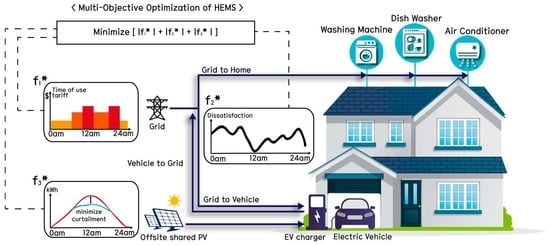Multi-Objective Optimization of Home Appliances and Electric Vehicle Considering Customer’s Benefits and Offsite Shared Photovoltaic Curtailment
Abstract
1. Introduction
2. Literature Review
3. HEMS Model for the Residential Community
4. Methodology
4.1. Mathematical Modeling
4.1.1. Shiftable Appliances
4.1.2. Controllable Appliance
4.1.3. Interruptible Appliance
4.1.4. Setting the Dissatisfaction Weight
4.1.5. Parameters
4.2. Multi-Objective Function
4.2.1. Multi-Objective Function
4.2.2. Normalization
4.2.3. Priority Method
5. Analysis of the Results
5.1. Case Results at EV Battery Capacity 36 kWh
5.2. Case Results by Various EV Battery Capacities
6. Discussion and Conclusion
- Multi-objective optimal scheduling considering cost and dissatisfaction by using the On/Off pattern for each appliance as the dissatisfaction weight for each time slot.
- It is proposed to optimize scheduling of EV charging and minimizing the cost and dissatisfaction of individuals with the aim of minimizing the curtailment of PV shared by multiple households.
Author Contributions
Funding
Acknowledgments
Conflicts of Interest
Nomenclature
| Symbol | Description |
| HEMS | Home Energy Management System |
| TOU tariff | Time of Use tariff |
| EV | Electric Vehicle |
| PV | Photovoltaic |
| Electricity price at time t | |
| Electric vehicle charging price at time t | |
| Electric vehicle discharging selling price at time t | |
| on/off status of appliance i at time t | |
| Real energy consumption data based appliance on/off states | |
| Optimized appliance’s on/off status | |
| Optimal power of appliance i at time t | |
| Time slot in which the appliance i was worked | |
| Shiftable appliance i operating time | |
| the on/off state of the home appliance at time t on day d | |
| mean value of appliance energy consumption data at time t on day d | |
| standard deviation of appliance energy consumption data at time t on day d | |
| the probability value that the appliances is ‘on’ at time t | |
| the dissatisfaction weight at time t | |
| Indoor temperature | |
| Customer preferred temperature | |
| Outdoor temperature | |
| System inertia of air conditioner | |
| Efficiency of air conditioner | |
| Electric vehicle charging power at time t | |
| Electric vehicle discharging power at time t | |
| State of charge of electric vehicle at time t | |
| Initial state of charge of electric vehicle | |
| Maximum state of charge of electric vehicle | |
| Minimum state of charge of electric vehicle | |
| Electric vehicle battery capacity | |
| Electric vehicle charging efficiency | |
| Electric vehicle discharging efficiency | |
| Electric vehicle arriving time | |
| Electric vehicle departure time | |
| wm | Shiftable appliance—washing machine |
| dw | Shiftable appliance—dish washer |
| ev | Interruptible appliance—electric vehicle |
| ac | Controllable appliance—air conditioner |
References
- Almusaylim, Z.A.; Zaman, N. A review on smart home present state and challenges: Linked to context-awareness internet of things (IoT). Wirel. Netw. 2018, 25, 3193–3204. [Google Scholar] [CrossRef]
- Khedekar, D.C.; Truco, A.C.; Oteyza, D.A.; Huertas, G.F. Home Automation-A Fast-Expanding Market. Thunderbird Int. Bus. Rev. 2017, 59, 79–91. [Google Scholar] [CrossRef]
- Chauhan, A.S. How AI Is Transforming Home Automation. Available online: https://becominghuman.ai/how-ai-is-transforming-home-automation-56085cb275b (accessed on 4 April 2020).
- Ejaz, W.; Naeem, M.; Shahid, A.; Anpalagan, A.; Jo, M. Efficient energy management for the internet of things in smart cities. IEEE Commun. Mag. 2017, 55, 84–91. [Google Scholar] [CrossRef]
- Yoldaş, Y.; Önen, A.; Muyeen, S.M.; Vasilakos, A.V.; Alan, İ. Enhancing smart grid with microgrids: Challenges and opportunities. Renew. Sustain. Energy Rev. 2017, 72, 205–214. [Google Scholar] [CrossRef]
- Phuangpornpitak, N.; Tia, S. Opportunities and Challenges of Integrating Renewable Energy in Smart Grid System. Energy Procedia 2013, 34, 282–290. [Google Scholar] [CrossRef]
- Uribe-Pérez, N.; Hernández, L.; de la Vega, D.; Angulo, I. State of the Art and Trends Review of Smart Metering in Electricity Grids. Appl. Sci. 2016, 6, 68. [Google Scholar] [CrossRef]
- Tan, K.M.; Ramachandaramurthy, V.K.; Yong, J.Y. Integration of electric vehicles in smart grid: A review on vehicle to grid technologies and optimization techniques. Renew. Sustain. Energy Rev. 2016, 53, 720–732. [Google Scholar] [CrossRef]
- Benefits of Demand Response in Electricity Markets and Recommendations for Achieving Them; U.S. Department of Energy: Washington, DC, USA, 2006.
- Paranjape, Z.W.U.M.R. Stochastic Optimization for Residential Demand Response under Time of Use. In Proceedings of the IEEE International Conference on Power Electronics, Smart Grid and Renewable Energy (PESGRE2020), Cochin, India, 2–4 January 2020. [Google Scholar]
- Zhao, L.; Yang, Z.; Lee, W.-J. The Impact of Time-of-Use (TOU) Rate Structure on Consumption Patterns of the Residential Customers. IEEE Trans. Ind. Appl. 2017, 53, 5130–5138. [Google Scholar] [CrossRef]
- Hussain, H.; Javaid, N.; Iqbal, S.; Hasan, Q.; Aurangzeb, K.; Alhussein, M. An Efficient Demand Side Management System with a New Optimized Home Energy Management Controller in Smart Grid. Energies 2018, 11, 190. [Google Scholar] [CrossRef]
- Veras, J.M.; Silva, I.R.S.; Pinheiro, P.R.; Rabelo, R.A.L.; Veloso, A.F.S.; Borges, F.A.S.; Rodrigues, J. A Multi-Objective Demand Response Optimization Model for Scheduling Loads in a Home Energy Management System. Sensors 2018, 18, 3207. [Google Scholar] [CrossRef]
- Zhu, Z.; Tang, J.; Lambotharan, S.; Chin, W.H.; Fan, Z. An Integer Linear Programming and Game Theory Based Optimization for Demand Side Management in Smart Grid. In Proceedings of the 2011 IEEE GLOBECOM Workshops (GC Wkshps), Houston, TX, USA, 5–9 December 2011; pp. 1205–1210. [Google Scholar]
- Parida, B.; Iniyan, S.; Goic, R. A review of solar photovoltaic technologies. Renew. Sustain. Energy Rev. 2011, 15, 1625–1636. [Google Scholar] [CrossRef]
- Nguyen, D.T.; Le, L.B. Joint Optimization of Electric Vehicle and Home Energy Scheduling Considering User Comfort Preference. IEEE Trans. Smart Grid 2014, 5, 188–199. [Google Scholar] [CrossRef]
- Shoji, T.; Hirohashi, W.; Fujimoto, Y.; Hayashi, Y. Home Energy Management Based on Bayesian Network Considering Resident Convenience. In Proceedings of the 2014 International Conference on Probabilistic Methods Applied to Power Systems (PMAPS), Durham, UK, 7–10 July 2014; IEEE: Durham, UK, 2014; pp. 1–6. [Google Scholar]
- Rastegar, M. Impacts of Residential Energy Management on Reliability of Distribution Systems Considering a Customer Satisfaction Model. IEEE Trans. Power Syst. 2018, 33, 6062–6073. [Google Scholar] [CrossRef]
- Zhu, J.; Lin, Y.; Lei, W.; Liu, Y.; Tao, M. Optimal household appliances scheduling of multiple smart homes using an improved cooperative algorithm. Energy 2019, 171, 944–955. [Google Scholar] [CrossRef]
- Joo, I.-Y.; Choi, D.-H. Optimal household appliance scheduling considering consumer’s electricity bill target. IEEE Trans. Consum. Electron. 2017, 63, 19–27. [Google Scholar] [CrossRef]
- Khan, A.; Javaid, N.; Khan, M.I. Time and device based priority induced comfort management in smart home within the consumer budget limitation. Sustain. Cities Soc. 2018, 41, 538–555. [Google Scholar] [CrossRef]
- Li, K.; Zhang, P.; Li, G.; Wang, F.; Mi, Z.; Chen, H. Day-Ahead Optimal Joint Scheduling Model of Electric and Natural Gas Appliances for Home Integrated Energy Management. IEEE Access 2019, 7, 133628–133640. [Google Scholar] [CrossRef]
- Tushar, M.H.K.; Assi, C.; Maier, M.; Uddin, M.F. Smart microgrids: Optimal joint scheduling for electric vehicles and home appliances. IEEE Trans. Smart Grid 2014, 5, 239–250. [Google Scholar] [CrossRef]
- Aoun, A.; Ibrahim, H.; Ghandour, M.; Ilinca, A. Supply Side Management vs. Demand Side Management of a Residential Microgrid Equipped with an Electric Vehicle in a Dual Tariff Scheme. Energies 2019, 12, 4351. [Google Scholar] [CrossRef]
- He, Y.; Venkatesh, B.; Guan, L. Optimal Scheduling for Charging and Discharging of Electric Vehicles. IEEE Trans. Smart Grid 2012, 3, 1095–1105. [Google Scholar] [CrossRef]
- Rastegar, M.; Fotuhi-Firuzabad, M.; Moeini- Aghtaie, M. Developing a Two-Level Framework for Residential Energy Management. IEEE Trans. Smart Grid 2016, 9, 1707–1717. [Google Scholar] [CrossRef]
- Ioakimidis, C.S.; Thomas, D.; Rycerski, P.; Genikomsakis, K.N. Peak shaving and valley filling of power consumption profile in non-residential buildings using an electric vehicle parking lot. Energy 2018, 148, 148–158. [Google Scholar] [CrossRef]
- Ito, A.; Kawashima, A.; Suzuki, T.; Inagaki, S.; Yamaguchi, T.; Zhou, Z. Model Predictive Charging Control of In-Vehicle Batteries for Home Energy Management Based on Vehicle State Prediction. IEEE Trans. Control. Syst. Technol. 2018, 26, 51–64. [Google Scholar] [CrossRef]
- Kikusato, H.; Mori, K.; Yoshizawa, S.; Fujimoto, Y.; Asano, H.; Hayashi, Y.; Kawashima, A.; Inagaki, S.; Suzuki, T. Electric Vehicle Charge–Discharge Management for Utilization of Photovoltaic by Coordination Between Home and Grid Energy Management Systems. IEEE Trans. Smart Grid 2019, 10, 3186–3197. [Google Scholar] [CrossRef]
- Pecan Street. Available online: https://www.pecanstreet.org/dataport/ (accessed on 9 October 2019).
- Tang, Y.; Sakai, K.; Luo, S.; Zhao, Y. AI in Depth: Monitoring Home Appliances from Power Readings with ML. Available online: https://cloud.google.com/blog/products/ai-machine-learning/monitoring-home-appliances-from-power-readings-with-ml (accessed on 30 November 2019).
- WIKIPEDIA Percentil Rank. Available online: https://en.wikipedia.org/wiki/Percentile_rank (accessed on 10 January 2020).
- Setlhaolo, D.; Xia, X.; Zhang, J. Optimal scheduling of household appliances for demand response. Electr. Power Syst. Res. 2014, 116, 24–28. [Google Scholar] [CrossRef]
- Ma, Y.; Houghton, T.; Cruden, A.; Infield, D. Modeling the Benefits of Vehicle-to-Grid Technology to a Power System. IEEE Trans. Power Syst. 2012, 27, 1012–1020. [Google Scholar] [CrossRef]
- Arif, S.M.; Lie, T.T.; Seet, B.C.; Ahsan, S.M.; Khan, H.A. Plug-In Electric Bus Depot Charging with PV and ESS and Their Impact on LV Feeder. Energies 2020, 13, 2139. [Google Scholar] [CrossRef]
- IBM ILOG CPLEX Optimization Studio. Available online: https://www.ibm.com/nl-en/products/ilog-cplex-optimization-studio (accessed on 5 February 2020).
- Arora, J.S. Multi-objective Optimum Design Concepts and Methods. In Introduction to Optimum Design; Elsevier: Cambridge, MA, USA, 2017; pp. 771–794. [Google Scholar]
- Yahia, Z.; Pradhan, A. Multi-objective optimization of household appliance scheduling problem considering consumer preference and peak load reduction. Sustain. Cities Soc. 2020, 55, 102058. [Google Scholar] [CrossRef]
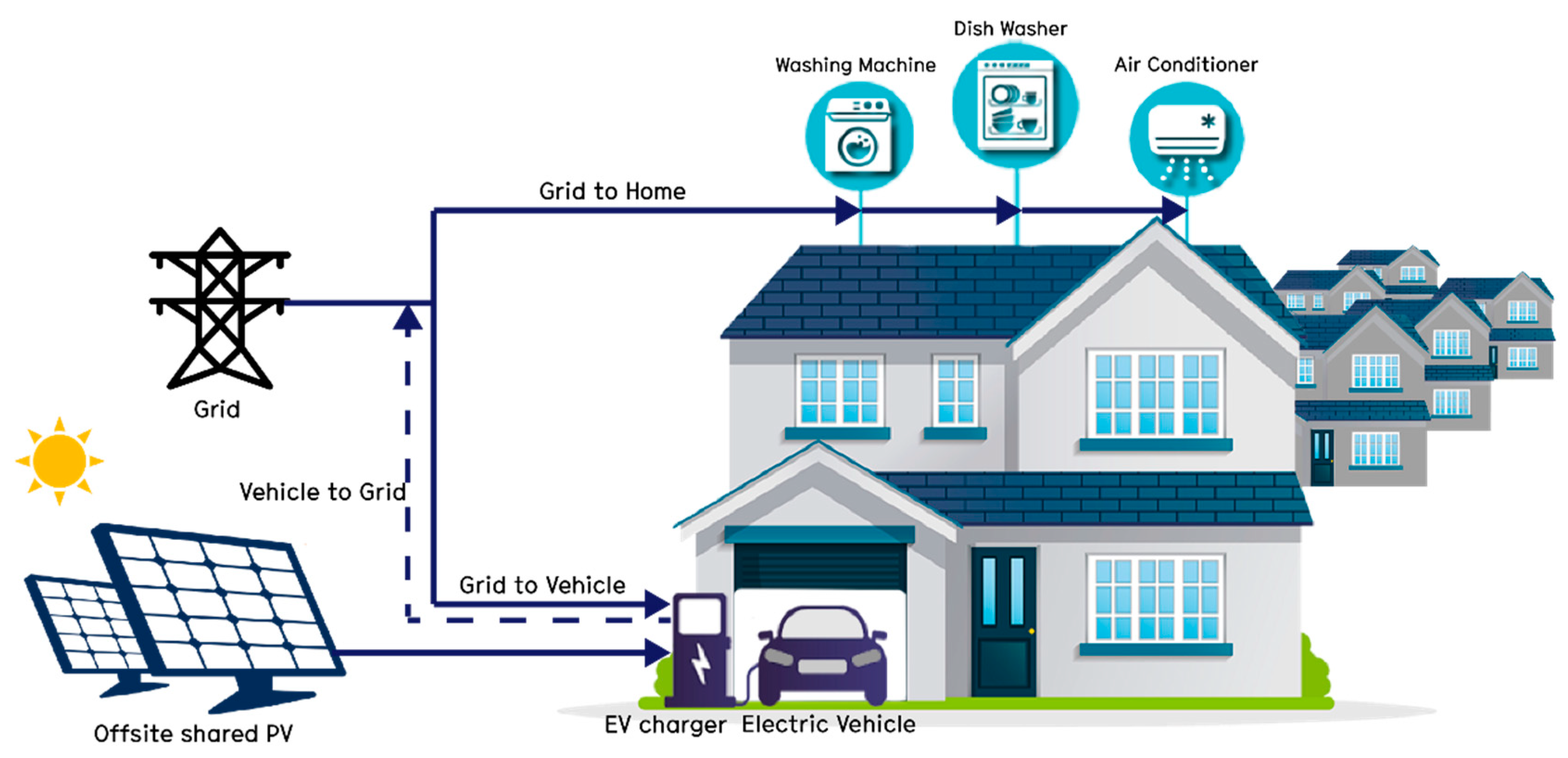
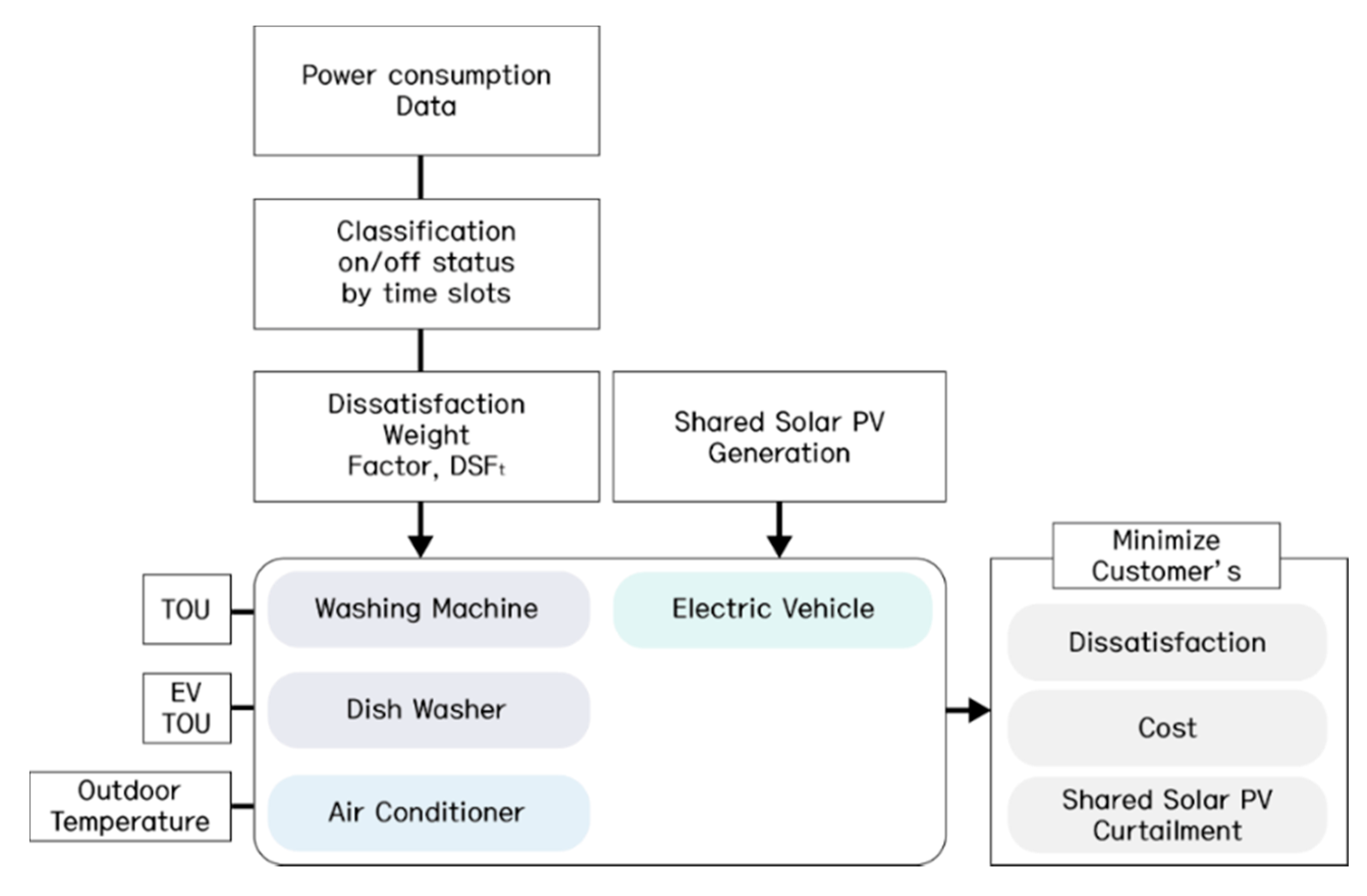
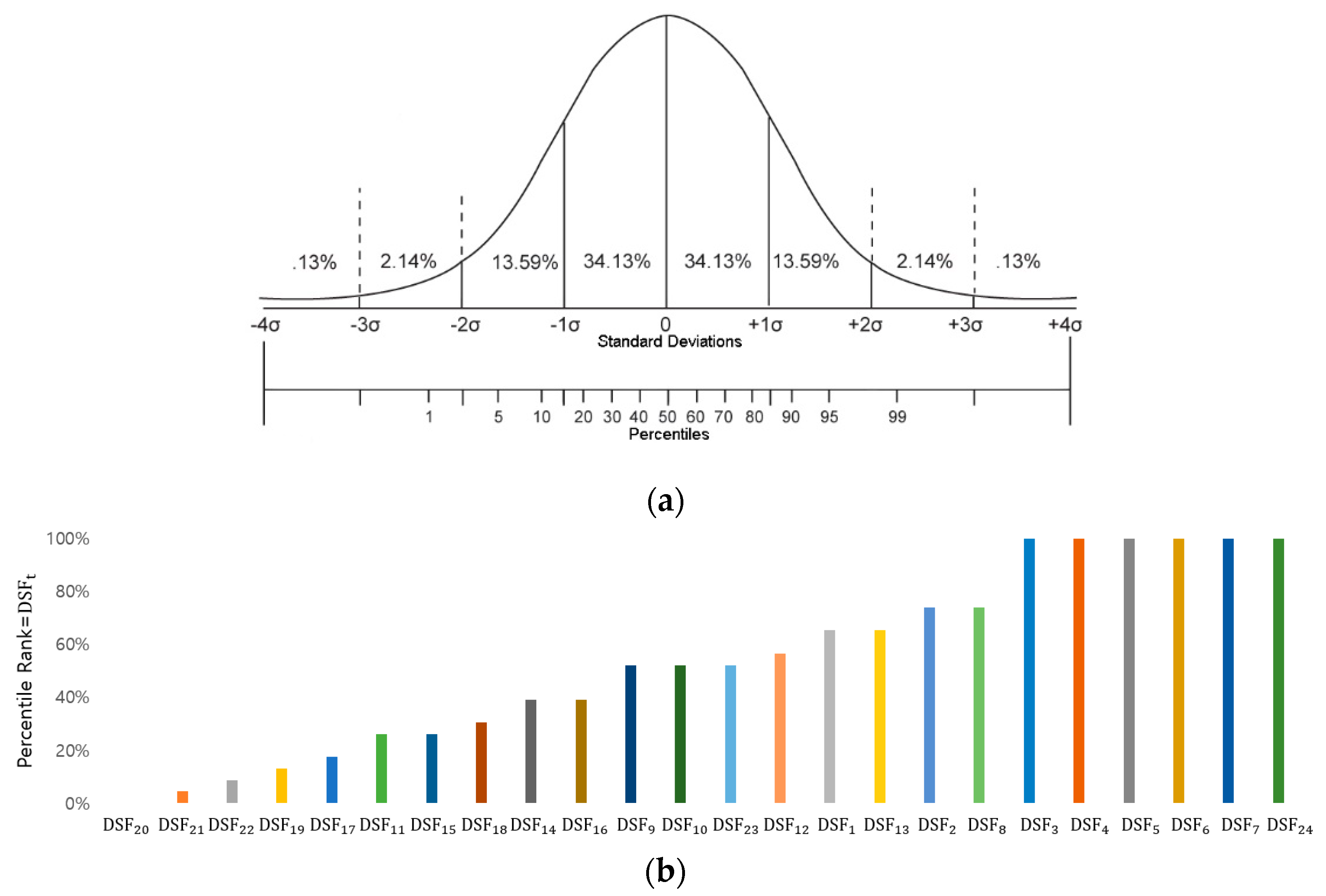

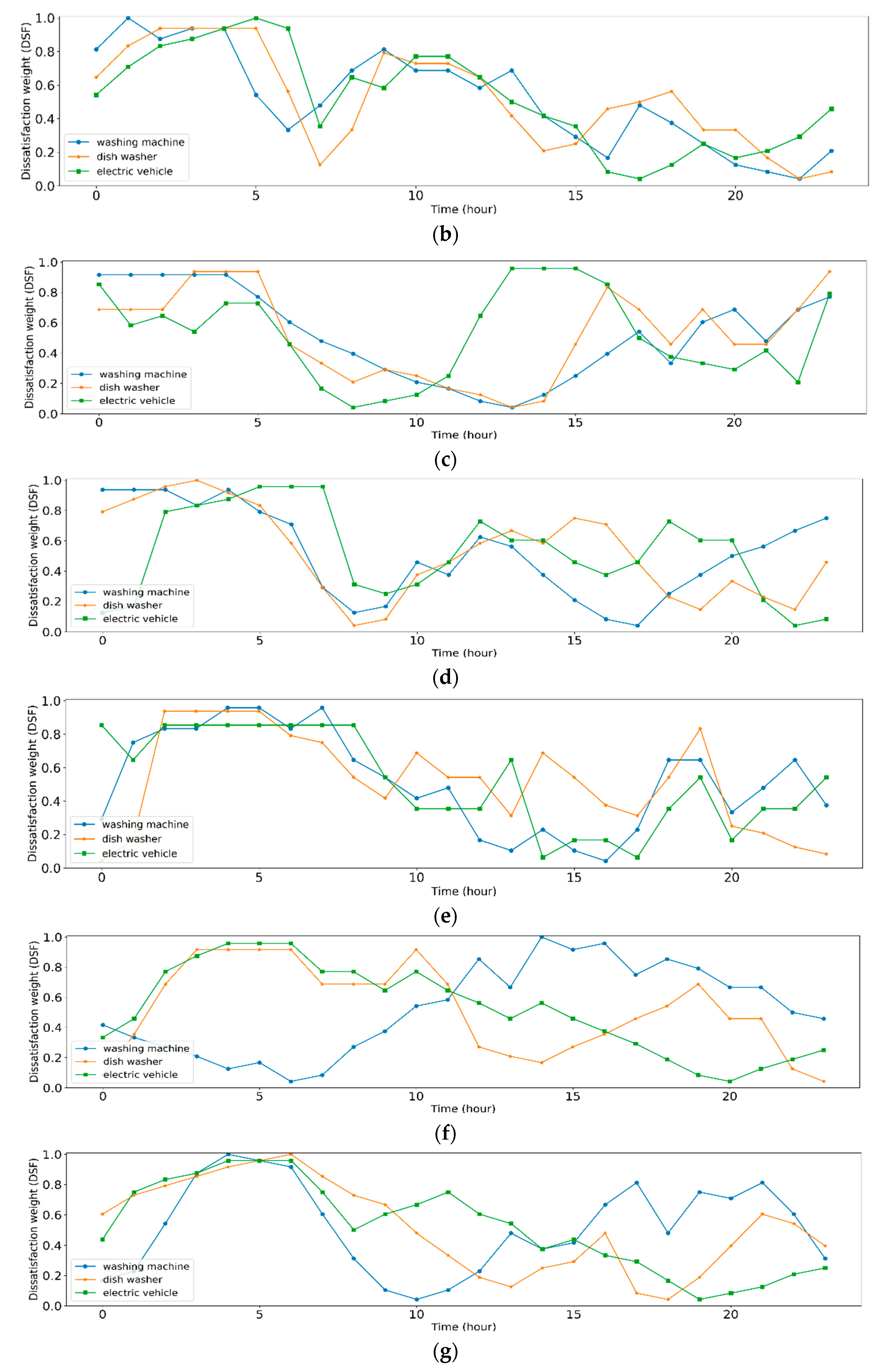

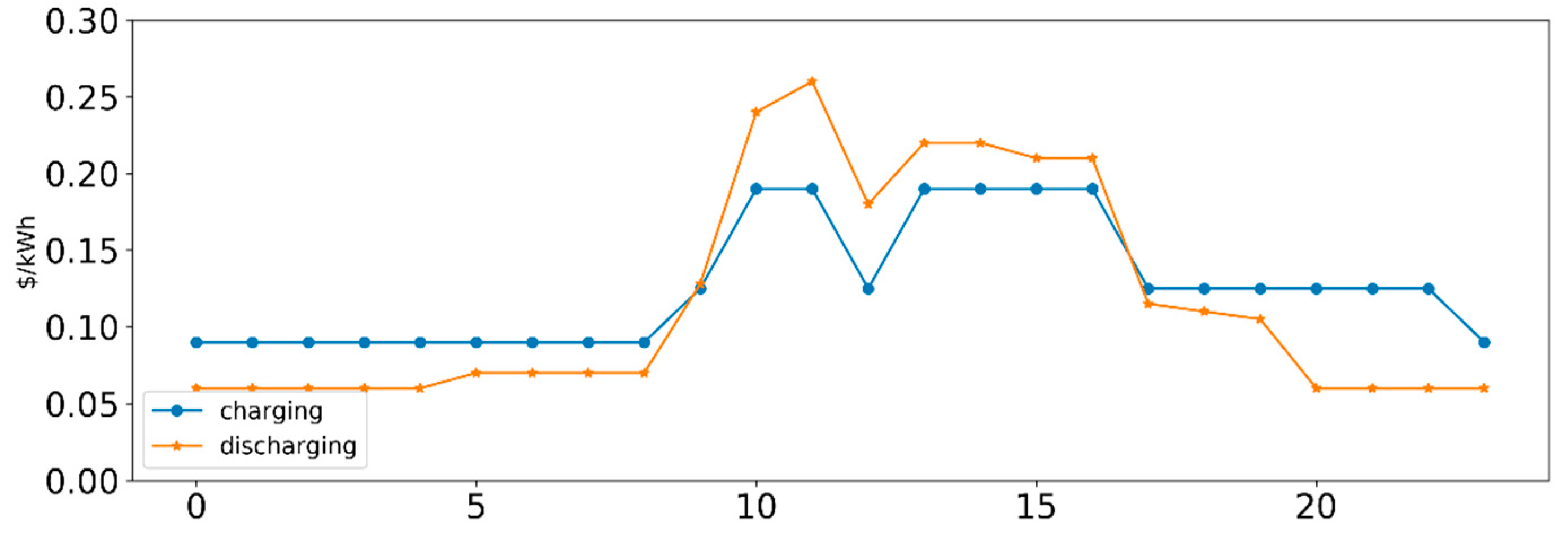


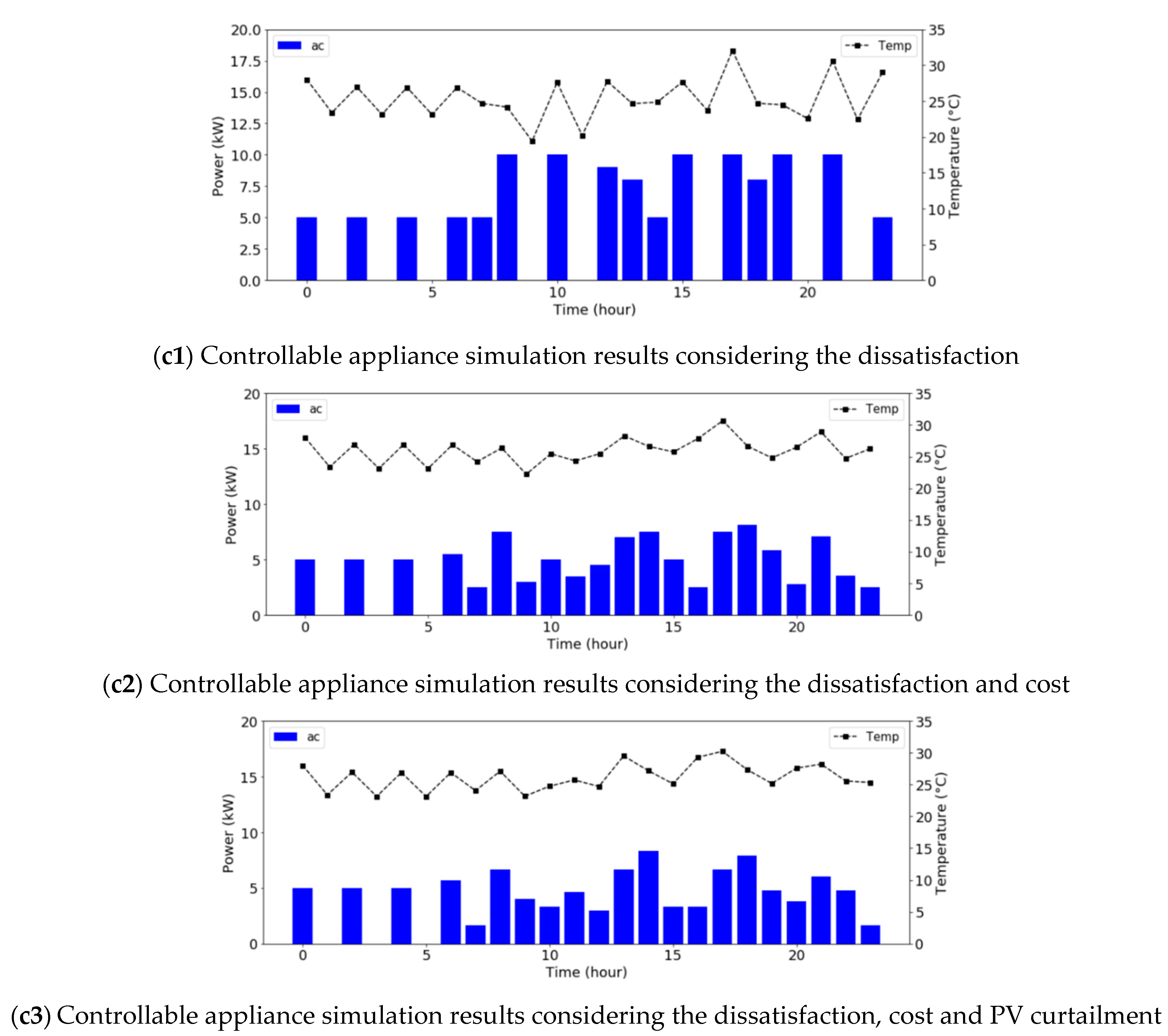
| House | Binary Optimal Cost ($/Day) | Proposed Optimal Cost ($/Day) |
|---|---|---|
| #1 | 6.10 | 5.44 |
| #2 | 6.46 | 5.56 |
| #3 | 6.38 | 4.86 |
| #4 | 5.95 | 5.42 |
| #5 | 7.90 | 6.13 |
| #6 | 6.07 | 5.41 |
| #7 | 6.58 | 5.43 |
| Appliances | Power (kWh) | Operation Durations (h) | |||
| Washing Machine | 2 | 2 | - | ||
| Dish Washer | 2 | 1 | - | ||
| Air Conditioner | 5–10 | - | - | ||
| Appliances | Capacity | SOCmax | SOCmin | ||
| Electric Vehicle | 60 kWh | 0.85 | 0.1 | 2, 4, 6 kW | 0.9 |
| Case | EV Battery Capacity (kWh) | Dissatisfaction | Cost ($/Day) | PV Curtailment (kWh/Day) |
|---|---|---|---|---|
| 1 | 36 | 0.13 | 18.77 | 59.48 |
| 48 | 0.29 | 19.88 | 58.33 | |
| 60 | 0.50 | 20.47 | 54.92 | |
| 72 | 0.82 | 21.17 | 52.38 | |
| 84 | 1.23 | 21.71 | 49.01 | |
| 2 | 36 | 2.61 | 10.34 | 51.99 |
| 48 | 2.93 | 11.38 | 50.13 | |
| 60 | 3.50 | 12.05 | 47.01 | |
| 72 | 3.59 | 13.14 | 44.99 | |
| 84 | 3.64 | 14.27 | 43.12 | |
| 3 | 36 | 4.24 | 9.45 | 45.69 |
| 48 | 4.38 | 10.77 | 42.80 | |
| 60 | 4.01 | 12.15 | 39.92 | |
| 72 | 3.84 | 13.45 | 37.92 | |
| 84 | 3.72 | 14.58 | 37.51 |
© 2020 by the authors. Licensee MDPI, Basel, Switzerland. This article is an open access article distributed under the terms and conditions of the Creative Commons Attribution (CC BY) license (http://creativecommons.org/licenses/by/4.0/).
Share and Cite
Kwon, Y.; Kim, T.; Baek, K.; Kim, J. Multi-Objective Optimization of Home Appliances and Electric Vehicle Considering Customer’s Benefits and Offsite Shared Photovoltaic Curtailment. Energies 2020, 13, 2852. https://doi.org/10.3390/en13112852
Kwon Y, Kim T, Baek K, Kim J. Multi-Objective Optimization of Home Appliances and Electric Vehicle Considering Customer’s Benefits and Offsite Shared Photovoltaic Curtailment. Energies. 2020; 13(11):2852. https://doi.org/10.3390/en13112852
Chicago/Turabian StyleKwon, Yeongenn, Taeyoung Kim, Keon Baek, and Jinho Kim. 2020. "Multi-Objective Optimization of Home Appliances and Electric Vehicle Considering Customer’s Benefits and Offsite Shared Photovoltaic Curtailment" Energies 13, no. 11: 2852. https://doi.org/10.3390/en13112852
APA StyleKwon, Y., Kim, T., Baek, K., & Kim, J. (2020). Multi-Objective Optimization of Home Appliances and Electric Vehicle Considering Customer’s Benefits and Offsite Shared Photovoltaic Curtailment. Energies, 13(11), 2852. https://doi.org/10.3390/en13112852




